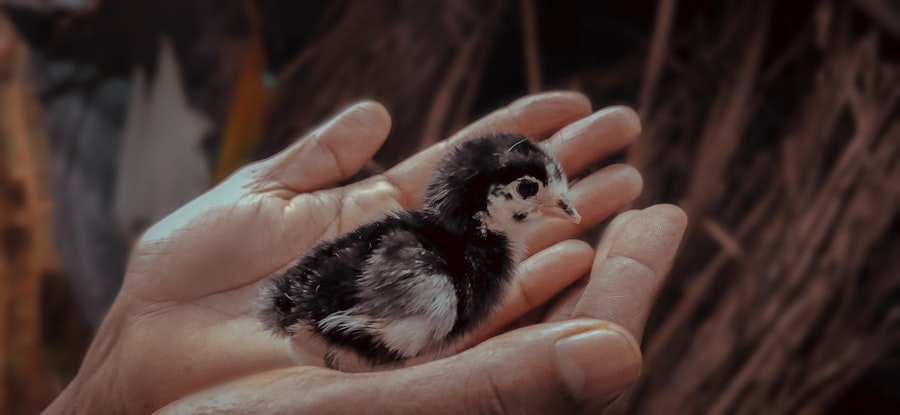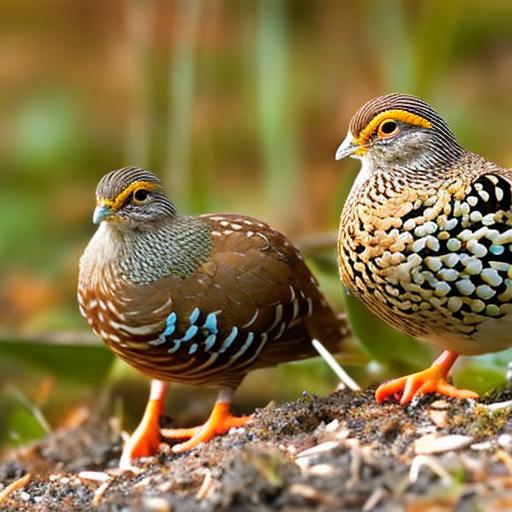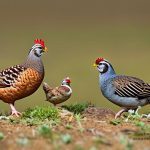Keeping button quail with chickens can be a rewarding experience for poultry enthusiasts. Button quail, also known as Chinese painted quail, are small, ground-dwelling birds that are native to Southeast Asia. They are popular for their colorful plumage and small size, making them an attractive addition to any poultry flock. When kept with chickens, button quail can add diversity to the flock and provide entertainment with their unique behaviors. However, there are several important considerations to keep in mind when integrating button quail with chickens, including housing, feeding, health concerns, social dynamics, and breeding. By understanding these factors, poultry keepers can successfully maintain a harmonious and thriving mixed flock of button quail and chickens.
Key Takeaways
- Keeping button quail with chickens can be a rewarding experience, but it requires careful consideration and planning.
- When housing button quail and chickens together, it’s important to provide separate areas for each species to prevent aggression and ensure their safety.
- Both button quail and chickens have specific dietary needs, so it’s important to provide a balanced and appropriate diet for each species.
- Health and safety concerns when keeping button quail with chickens include the risk of disease transmission and potential for injury from larger birds.
- Understanding the social dynamics and behavior of button quail and chickens is crucial for creating a harmonious living environment for both species.
Housing and Coop Considerations for Button Quail and Chickens
When keeping button quail with chickens, it is essential to provide appropriate housing and coop considerations to ensure the well-being of both species. Button quail require a different type of housing compared to chickens due to their small size and ground-dwelling nature. A separate enclosure within the chicken coop or a dedicated quail hutch is recommended to prevent any potential conflicts between the two species. The quail enclosure should have a solid bottom to prevent the quail from escaping or being injured by wire flooring. Additionally, providing hiding spots and low perches for the quail can help reduce stress and promote natural behaviors. It is important to ensure that the quail enclosure is secure from predators, as button quail are particularly vulnerable to attacks due to their small size. When integrating button quail with chickens, it is crucial to monitor the interactions between the two species and make adjustments to the housing setup if any issues arise.
On the other hand, chickens also require adequate space and amenities within the coop to accommodate the addition of button quail. Providing separate feeding and watering stations for the quail can help prevent competition and ensure that all birds have access to essential resources. Additionally, ensuring that the coop has sufficient ventilation and lighting can benefit both button quail and chickens. By carefully planning the housing and coop setup for button quail and chickens, poultry keepers can create a safe and comfortable environment for both species to thrive.
Feeding and Nutrition for Button Quail and Chickens
Feeding and nutrition are crucial aspects to consider when keeping button quail with chickens. Button quail have specific dietary requirements that differ from those of chickens, and it is important to provide a balanced diet for both species. Button quail are primarily ground foragers and consume a variety of seeds, insects, and greens in the wild. In captivity, they can be fed a commercial game bird feed supplemented with small seeds, mealworms, and fresh greens. It is important to ensure that the quail feed is appropriate for their nutritional needs, as they require higher protein levels compared to chickens. Additionally, providing access to grit and calcium supplements can help support the health of button quail, especially during periods of egg laying.
Chickens also have specific dietary needs that must be met to maintain their health and productivity. A balanced diet for chickens typically consists of a commercial layer feed supplemented with kitchen scraps, grains, and occasional treats. When integrating button quail with chickens, it is important to monitor their feeding habits and make adjustments as needed to prevent any issues such as food aggression or nutrient deficiencies. Providing separate feeding stations for button quail within the coop can help ensure that they have access to their specific dietary requirements without competition from the chickens. By carefully managing the feeding and nutrition of both button quail and chickens, poultry keepers can promote optimal health and well-being for all birds in the mixed flock.
Health and Safety Concerns when Keeping Button Quail with Chickens
Maintaining the health and safety of button quail and chickens is a top priority when keeping these two species together. Button quail are particularly susceptible to stress-related health issues, so it is important to minimize potential stressors within the mixed flock. Providing adequate hiding spots, low perches, and a secure enclosure can help reduce stress for button quail. Additionally, monitoring the interactions between button quail and chickens can help identify any aggressive behaviors or bullying that may pose a risk to the quail’s well-being. It is important to be vigilant for signs of illness or injury in both button quail and chickens, as early detection can lead to prompt treatment and prevent the spread of disease within the flock.
Furthermore, biosecurity measures should be implemented to prevent the transmission of diseases between button quail and chickens. This includes practicing good hygiene, quarantining new birds before introducing them to the flock, and regularly cleaning and disinfecting the coop and surrounding areas. Additionally, providing regular veterinary care for both button quail and chickens can help ensure that any health concerns are addressed promptly. By prioritizing the health and safety of both species within the mixed flock, poultry keepers can create a thriving and sustainable environment for button quail and chickens.
Social Dynamics and Behavior of Button Quail and Chickens
Understanding the social dynamics and behavior of button quail and chickens is essential for maintaining a harmonious mixed flock. Button quail are known for their shy and skittish nature, often preferring to stay close to cover or hide when they feel threatened. When kept with chickens, it is important to provide adequate hiding spots and low perches for button quail to retreat to when they feel stressed or overwhelmed. Additionally, monitoring the interactions between button quail and chickens can help identify any aggressive behaviors or bullying that may occur within the flock. By observing the social dynamics between the two species, poultry keepers can intervene if necessary to prevent any conflicts or stress-related issues.
Chickens also have their own social hierarchy and pecking order within the flock, which can impact their interactions with button quail. It is important to introduce new birds gradually and monitor their integration into the existing flock to prevent any aggressive behaviors or territorial disputes. Providing multiple feeding stations and resources within the coop can help reduce competition among birds and promote peaceful coexistence between button quail and chickens. By understanding the social dynamics and behavior of both species, poultry keepers can create a supportive environment where button quail and chickens can thrive together.
Breeding and Reproduction for Button Quail and Chickens

Breeding and reproduction are natural behaviors for both button quail and chickens, and it is important to consider these aspects when keeping these two species together. Button quail are prolific breeders known for their small eggs and rapid maturation, making them an attractive option for poultry enthusiasts interested in breeding projects. When kept with chickens, it is important to provide separate nesting areas for button quail to lay their eggs without interference from the larger birds. Additionally, monitoring the breeding behavior of both species can help prevent any potential issues such as egg theft or aggression during mating.
Chickens also have specific breeding behaviors that should be taken into consideration when keeping them with button quail. Providing appropriate nesting boxes and ensuring that broody hens have space away from button quail can help promote successful hatching and rearing of chicks. Additionally, monitoring the interactions between broody hens and button quail can help prevent any potential conflicts or disturbances during the incubation period. By understanding the breeding behaviors of both species, poultry keepers can create a supportive environment for successful reproduction within the mixed flock.
Conclusion and Tips for Successfully Keeping Button Quail with Chickens
In conclusion, keeping button quail with chickens can be a rewarding experience that adds diversity and interest to a poultry flock. By carefully considering housing, feeding, health concerns, social dynamics, breeding, and reproduction, poultry keepers can successfully maintain a harmonious mixed flock of button quail and chickens. Some tips for successfully keeping button quail with chickens include providing separate housing within the coop or a dedicated quail hutch, ensuring appropriate feeding stations for both species, prioritizing the health and safety of all birds, understanding their social dynamics and behavior, and creating a supportive environment for breeding and reproduction.
Overall, integrating button quail with chickens requires careful planning and consideration of each species’ specific needs. With proper management and attention to detail, poultry keepers can create a thriving mixed flock where button quail and chickens coexist harmoniously while enjoying all the benefits each species has to offer.
If you’re considering keeping button quail with chickens, you may also be interested in learning about the ideal setup for your chicken coop. Poultry Wizard’s article on “The Chicken Coop Country Diner” provides valuable insights into creating a comfortable and functional space for your chickens. Understanding the best practices for coop design and maintenance can help ensure a harmonious environment for both your quail and chickens. Check out the article here to discover more about optimizing your chicken coop.
FAQs
What are button quail?
Button quail, also known as Chinese painted quail, are small ground-dwelling birds native to Southeast Asia. They are popular as pets due to their small size and colorful plumage.
Can button quail be kept with chickens?
Yes, button quail can be kept with chickens, but there are some considerations to keep in mind. It’s important to provide separate housing for the quail to ensure they are safe from larger, more aggressive chickens.
What should be considered when keeping button quail with chickens?
When keeping button quail with chickens, it’s important to provide separate housing to prevent any potential harm to the quail. Additionally, the quail should have access to their own food and water sources to ensure they are not outcompeted by the chickens.
Do button quail and chickens have similar care requirements?
Button quail and chickens have some similar care requirements, such as access to a balanced diet and protection from predators. However, button quail have specific needs, such as a smaller and more secure housing, that should be taken into consideration when keeping them with chickens.
Are there any potential issues with keeping button quail with chickens?
One potential issue with keeping button quail with chickens is the risk of aggression from the larger birds. Chickens may peck at or bully the quail, so it’s important to monitor their interactions and provide separate housing if necessary. Additionally, quail and chickens have different dietary needs, so it’s important to ensure the quail have access to their own food sources.
Meet Walter, the feathered-friend fanatic of Florida! Nestled in the sunshine state, Walter struts through life with his feathered companions, clucking his way to happiness. With a coop that’s fancier than a five-star hotel, he’s the Don Juan of the chicken world. When he’s not teaching his hens to do the cha-cha, you’ll find him in a heated debate with his prized rooster, Sir Clucks-a-Lot. Walter’s poultry passion is no yolk; he’s the sunny-side-up guy you never knew you needed in your flock of friends!







